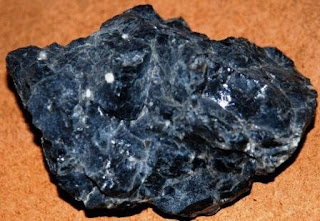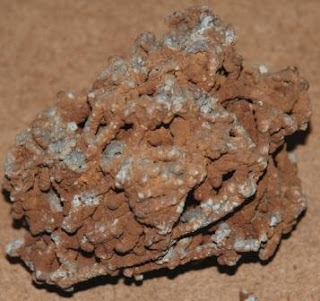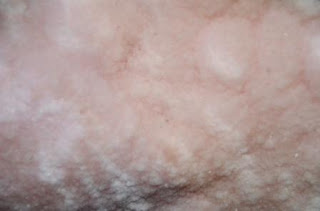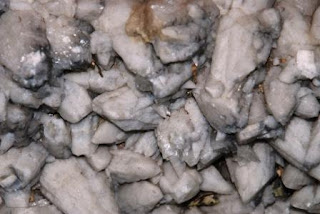
So it seems I like to take pictures of rocks. Actually I just like to take photos of things that show texture, color, patterns, and shapes. Rocks, gems, and minerals just happen to work out well into my desired parameters.

The Tucson Gem & Mineral Show is a great place to find treasures to shoot or take home. We have done both in the last couple of years and I expect that to continue. Most of the shots included in this post are either from the show or from my personal collection. I have mixed a few of them in with the cameras I also collect.
One of the new discoveries is a formation called septarian. There was varying and conflicting information on how it got the name, but I will include two explanations with this post. I actually like the rough specimens better than the polished. To each his own, as beauty is in the eye of the beholder.
Septarian concretions or septarian nodules, are concretions containing angular cavities or cracks, which are called "septaria". The word comes from the Latin word septum; "partition", and refers to the cracks/separations in this kind of rock. There is an incorrect explanation that it comes from the Latin word for "seven", septem, referring to the number of cracks that commonly occur. The process which created the septaria, which characterize septarian concretions, remains a mystery. A number of mechanisms, i.e. the dehydration of clay-rich, gel-rich, or organic-rich cores; shrinkage of the concretion's center; expansion of gases produced by the decay of organic matter; brittle fracturing of the concentration by either earthquakes or compaction; and others, have been proposed for the formation of septaria. At this time, it is uncertain, which, if any, of these and other proposed mechanisms is responsible for the formation of septaria in septarian concretions (McBride et al. 2003). Septaria usually contain crystals precipitated from circulating solutions, usually of calcite. Siderite or pyrite coatings are also occasionally observed on the wall of the cavities present in the septaria, giving rise respectively to a panoply of bright reddish and golden colors. Some septaria may also contain small calcite stalagtites and well-shaped millimetric pyrite single crystals. http://en.wikipedia.org/wiki/Concretion
As a result of volcanic eruptions, dead sea life was chemically attracted to the sediment around them, forming mud balls. As the ocean receded, the balls dried and cracked. Due to their bentonite content they also shrank in size, creating the cracks inside. As decomposed shells seeped down into the cracks in the mud balls, calcite crystals formed. The outer thin walls of calcite then transformed into aragonite. The name Septarian comes from the Latin word "septem", meaning seven, because the mud balls had a tendency to crack in 7 points in every direction, thereby creating the distinctive pattern these nodules exhibit. Septarians are composed of Calcite (The Yellow Centers), Aragonite (The Brown Lines), and the outer grey rock is Limestone. http://www.bestcrystals.com/septarian.htm
Another great place we visit to look at minerals is the U of Flandrau Science Center. They have one of the most unique collections of minerals. http://www.flandrau.org/
You can also learn more about the Miner’s Story Project there of at their website. http://www.minersstory.org/ or http://uaminersstory.ning.com/.

AZ Mining and Mineral Museum info
http://www.azminfun.com/
http://mines.az.gov/General/museum.html

Tucson Gem & Mineral Society, Inc. info
http://www.tgms.org/tgms.htm
You can also learn more about the Miner’s Story Project there of at their website. http://www.minersstory.org/ or http://uaminersstory.ning.com/.

AZ Mining and Mineral Museum info
http://www.azminfun.com/
http://mines.az.gov/General/museum.html

Tucson Gem & Mineral Society, Inc. info
http://www.tgms.org/tgms.htm
Tucson "Gem, Mineral & Fossil Showcase" info
http://tucsongemshowguide.com/
http://tucsongemandmineralshows.net/tucson-gem-show-dates.htm

Another fun discovery from the Gem & Mineral Show was some close-up photographs mounted on canvas. Check out some really cool artwork at:
http://www.mikewoodwardphotography.com/photoimages/webgalleryStones/AbstractStoneImages.htm

http://tucsongemshowguide.com/
http://tucsongemandmineralshows.net/tucson-gem-show-dates.htm

Another fun discovery from the Gem & Mineral Show was some close-up photographs mounted on canvas. Check out some really cool artwork at:
http://www.mikewoodwardphotography.com/photoimages/webgalleryStones/AbstractStoneImages.htm































1 comment:
Fine detail!! It's odd what one finds in the natural world!! Between the minerals and cave shots, you have captured this big old earth in a different light. Thanks for sharing.
Joellen
Post a Comment